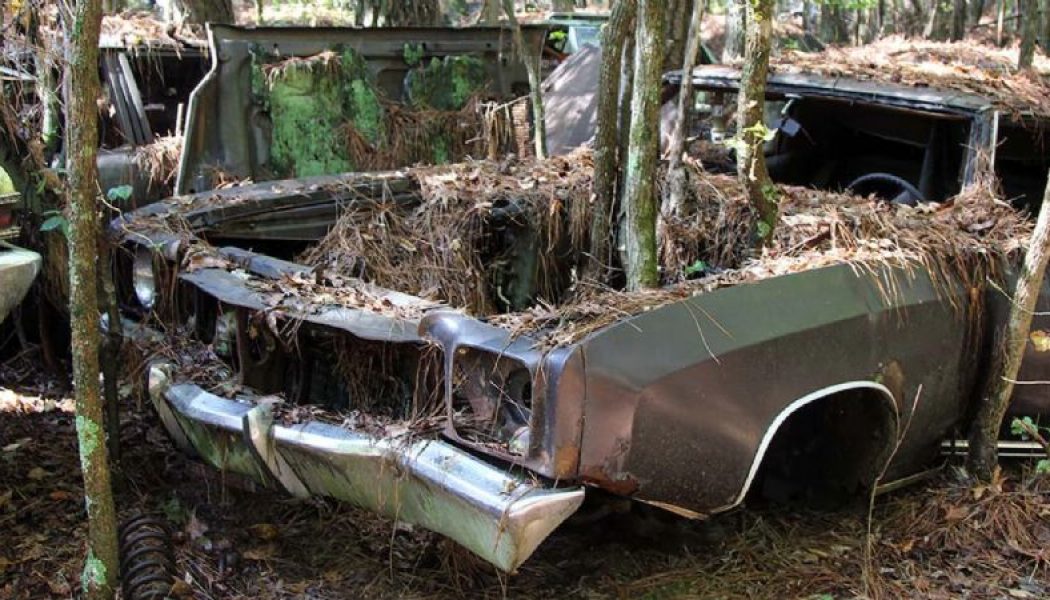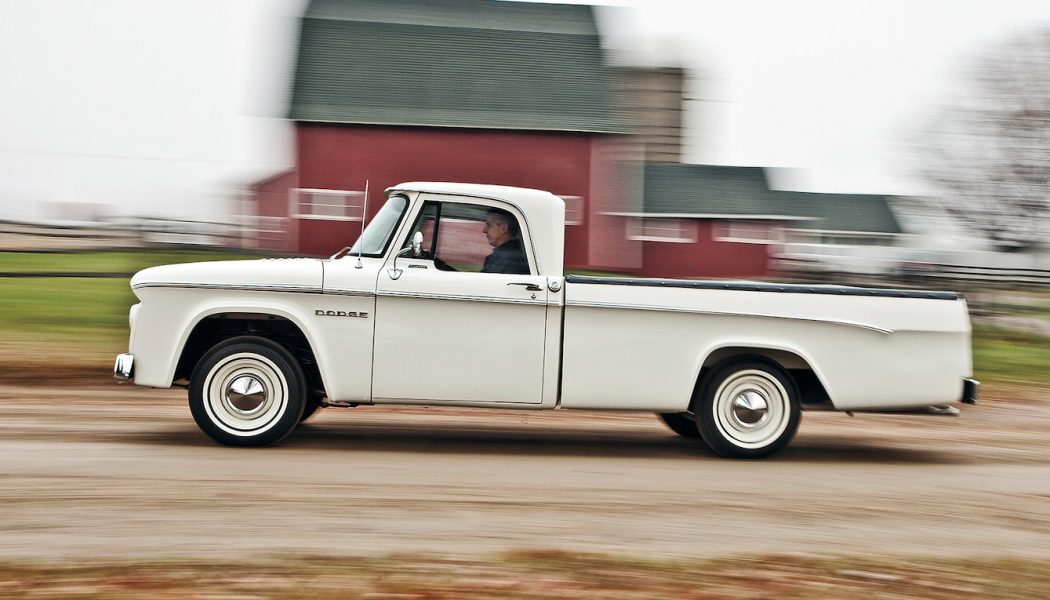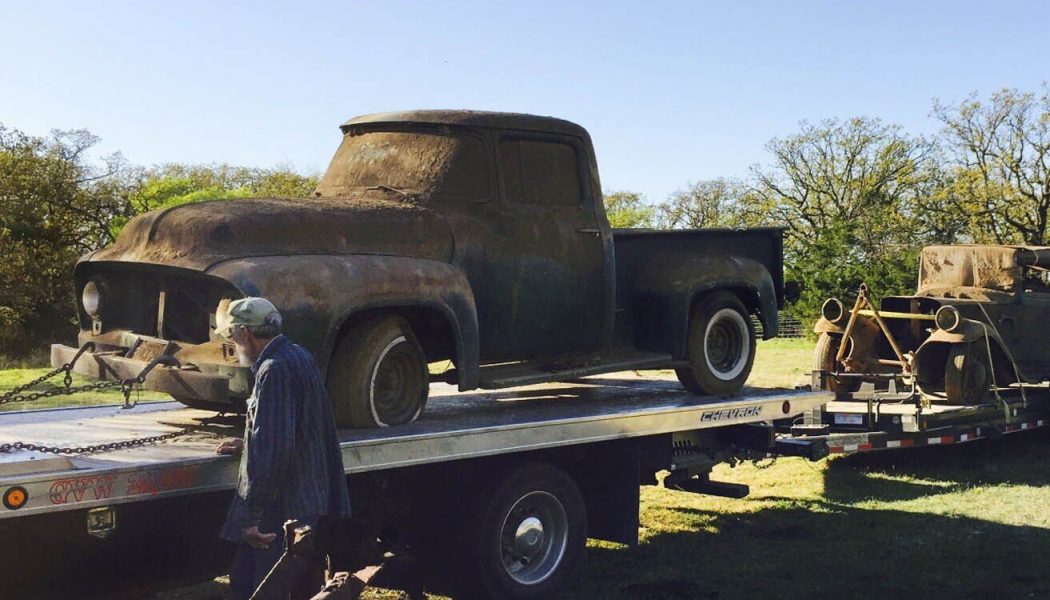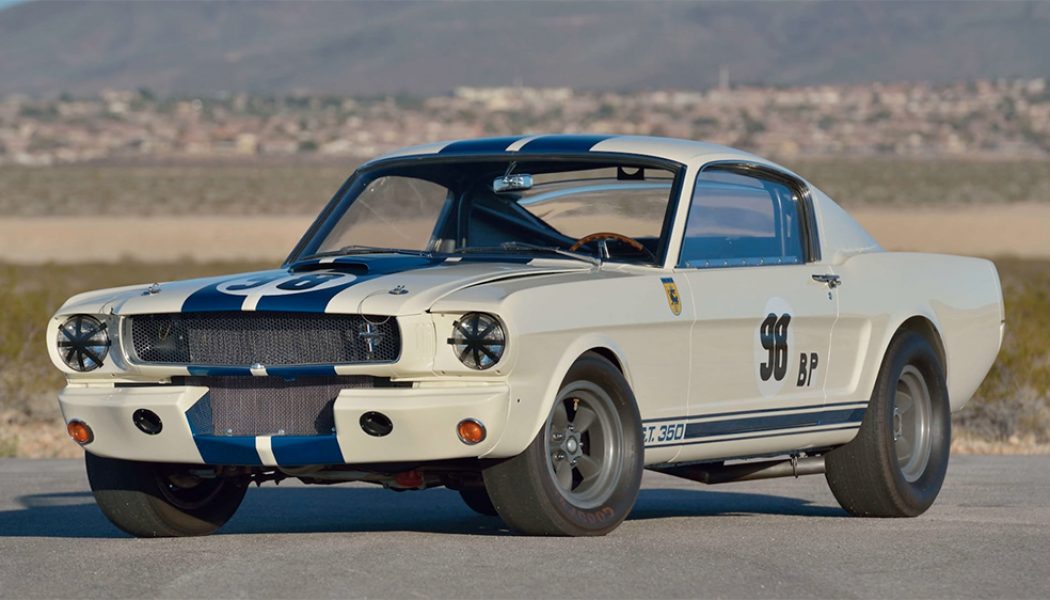Classic Cars
Old Car City U.S.A. Is Part Graveyard, Part Playground for Fans of Abandoned Classic Cars
This story originally ran in 2014 on Hot Rod. For more barn find and classic car content, check out Hot Rod Network. You’ve probably seen images from this place before. Big finned Cadillacs sinking slowly in the loam, a 1967 GTO peering out from waist-high weeds, vines curling around the mirrors and in and out of hood scoops, pre-safety glass windshields starred and fogged from decades of quiet resting in the woods. There are more than six miles of trails in and around the Georgia forest land that houses these picturesque scenes of abandonment, and the owner of it all, Dean Lewis, knows exactly how striking it is. See all 258 photos There is a sign on the fence that reads “CARS, ART, NATURE, HISTORY.” That sums up Dean’s approach to his 34-acre vintage car...
Max Factor: Hemi-Powered Dodge D-100 Was a Rebel In Its Time
THESE DAYS, factory hot-rod pickups are as commonplace as rock stars wearing guyliner, but all of them owe their heritage to the specially equipped Dodge D-100 Custom Sports Special you see here, which debuted in 1964—eight years before Ziggy Stardust painted his face. Yes, in the same year designer Mary Quant changed the fashion world forever with the miniskirt, Dodge attempted to upend the pickup-truck status quo by introducing a “personal-use” maximum-performance model of the D-100—a Hemi-powered hot rod truck lavishly trimmed with bucket seats and a console. Perhaps some spark of inspiration came from San Diego DJ Dick Boynton’s success racing his 1963 Dragmaster truck, a Dodge D-100 powered by a 413-cubic inch 420-horse Max Wedge engine that won its B/FX (factory exp...
Big Daddy Barn Find: Ed Roth’s 1956 Ford F-100 Found after 50 Years in Hiding
Ed Roth was a man of many talents: painter, pinstriper, airbrush artist, fabricator. He was also a great self-promoter. Roth understood that an artist working in obscurity would likely starve. Success meant getting the word out about your skills. In the early 1950s, Roth bought a 1948 Ford, painted it red, lettered it with the name of his business and phone number, and adorned the roof over the back window with papier-mache head and hands. Sort of a bizarre take on the old “Kilroy was Here” cartoon. But, as he told Tony Thacker in the book Hot Rods by Ed “Big Daddy” Roth, that head “drew too many complaints.” So in 1957, he bought a light green 1956 Ford F-100 pickup. Roth repainted the truck white and adorned it with red flames and added a tonneau cover...
Chevy’s Shark-Themed Concept Cars: The Apex Predators of Auto Shows in the 1960s
One of our favorite non-automotive times of the year is upon us: Discovery’s Shark Week 2020 began on Sunday, Aug. 9. As such, we’re thoroughly in the mood for some automotive sharkdom, and we figured this is a great time to look back at some of Chevrolet’s cool shark-themed concepts of the 1960s. 1961 Mako Shark concept: Selling the new Corvette Legend has it that the original Mako Shark concept car’s name and color scheme were inspired by the real thing—specifically, a mako shark that GM styling chief Bill Mitchell caught himself and had mounted in his office. The story goes that Mitchell insisted that the blue-grey-white blending on the show car exactly match the shark, and when his staff couldn’t get the car painted to his satisfaction, they stole the shar...
The Ultra-Rare Porsche 916 Is a Hot 911 Engine in a Big, Beefy 914 Body
You’re looking at a vehicle that represents two absolute extremes of Porsche in the early 1970s. On one hand, the Porsche 914 was a polarizing “junior” Porsche, derided for its Volkswagen roots and unusual styling. On the other hand, the 916 is a vision of a different future, in which the little mid-engined sports car received a huge dose of adrenaline in the form of big flat-six engines pulled straight from hotter 911s—much more extreme than the 914/6 cars upgraded with a mild 110-hp 2.0-liter flat-six. Even packing a big six displacing between 2.4 and 2.7 liters, the 914-based 916 was a small car. And the kind of performance brought by the engines in so small a package would have threatened the 911 substantially. That wasn’t the reason the 916 project was cancelled, but it was surely a c...
This 36K-Mile 1976 AMC Hornet Sportabout Is Preserved Malaise-Era “Luxury”
Sometimes you’re looking for a time capsule, not a track time. If you’re longing to spend some time in a bygone era, there’s not a lot that encapsulates the mid-1970s quite like an AMC product. And this Hornet Sportabout is basically a leisure suit dripping with disco sweat, sporting a Jimmy Carter campaign button and ready to dig into an open-face meatloaf and mashed-potato sandwich. Unlike many trends from an oft-mocked decade, however, this AMC (being offered up over at Hemmings Auctions) looks like it’ll endure. There are just 36,000 miles on the clock, and that’s barely broken in for the 258-cubic-inch inline-six, as it’s an engine with a legendary reputation for longevity if not outright power. The “deluxe” interior is described as like-new and looks it, although its vast plast...
Garage Find Lamborghini Miura S Spent 45 Years in Back of a Body Shop
Jeff Meier’s latest acquisition of the all-time great Lamborghini Miura–by way of a stunning garage find–is a heck of a story, filled with fortunate good luck. But his fascination with Lamborghini’s original supercar runs much deeper. Meier was born and raised in Cleveland, where he grew up in a large family. His father owned an automotive repair shop, so there were always different cars parked in the driveway. As early as the age of five, Meier developed a curiosity for cars that flourished into a hobby of identifying them when he’d see them driving on the road. The same kid that would shout out “Volkswagen,” “Chevy,” and “Ford” from the backseat when his father pointed at a car would one day become a full-fledged car expert and collector in his own right. The Lamborghini Miura Bug Bites ...
The Story of the Big, Four-Door Bronco That Presaged the Expedition
For years, the Ford Bronco was essentially the same vehicle: a stubby SUV with a removable roof. The early Broncos were smaller, and the rest (those without “II” in their names) adopted shortened full-size truck underpinnings, but the formula was otherwise basically recognizable. But even Ford was considering what a larger Bronco might look like before a fuel crisis scared them straight, though it took an aftermarket conversion by Centurion Vehicles to bring the four-door Bronco into reality. See all 5 photos Not that Centurion called it a Bronco. Instead, it was the “Centurion Classic,” built off a crew-cab version of the F-150 or F-350. The rear quarters and roof were sourced from a contemporary Bronco. The Michigan-based outfit built these conversions for ye...
Awesome Range Rover Coupe Restomod Is a Perfect Classic 4×4
The original two-door Land Rover Range Rover’s shape is a timeless and charming one, and this lovely restored SUV shows it off in all its glory. And it’s especially timeless because, in addition to the other modifications, it’s been back-dated to resemble an early 1970s model—including the body-colored C-pillar and early style silver bumpers. But the star of the show has to be the Tuscan Blue paint, available on early Range Rovers (and recently, on the Range Rover Fifty limited edition models). See all 17 photos The two-door Range Rovers look especially exotic and appealing to American eyes because they were never officially sold here. Later, four-door Range Rovers appeared, first through the grey market and later officially, but these two-doors remain a rare sight in Ame...
How a $700 Beater Became the 11-Second Roadkill Crop Duster
Here’s an intro to the old school for the young generation of Roadkillers. This is the Crop Duster—a 440-engine-swapped 1970 Plymouth Duster that runs in the 11s—which was built for what today would be considered cheap for a vintage muscle car. It’s also the story of the resurrection of an old car that spent years wallowing in farm soil laden with sundry vegetal and animal residue. “You’re still going to have 20 grand duplicating that car,” David Freiburger says in his trademark deadpan. “That’s the problem. That’s expensive.” But insofar that cubic dollars can be replaced by fanatic hoarding, ingenuity, and elbow grease, this is it. “The key to the whole thing—the reason why people think it’s cool—is the six pack scoop, Cra...
This 1965 Shelby GT350R Prototype Is the Most Expensive Mustang Ever
In the moments following the record sale of one of two ex-Steve McQueen and Bullitt film cars, a weathered and battered Highland Green 1968 Ford Mustang GT 390, we wondered if another Mustang could ever match its final price of $3.74 million. We didn’t have to wait long to find out. Just half a year later, 1965 Shelby GT350R serial number 5R002—the first of two Shelby Mustang team prototypes for the 34 subsequent production Shelby GT350Rs—has sold for $3.85 million, resetting the world-record Mustang sales price. Any time bidding reaches the seven-figure range for a Ford Mustang variant, it’s a big deal, but in this case, it was really no surprise. See all 12 photos When Ford launched its Mustang sports coupe in 1964, the pony car was heavy on style but light on performanc...
Iconic Dean Moon “Moonburst” Dragster Found After 43 Years in Storage
Around 1980, Michael Lightbourn spotted an odd, enclosed car trailer off to the side of a cotton farm on the outskirts of Fabens, Texas. He eventually met the owner, Bob Kimpel, who unlocked the trailer’s door and let Lightbourn peek inside. There, he eyeballed the back of a single-seat, tube-frame race car that stretched 188 inches as it ran toward the trailer’s nose. Kimpel explained this old race car was named “Moonburst” and had been featured in an issue of HOT ROD magazine; it was also spun from famed hot-rodder and racer Dean Moon’s shop—if you somehow don’t know the name, you definitely know the Mooneyes logo. Feeling the sense of awe and wonder that comes with uncovering buried treasure, Lightbourn was eager to buy. Kimpel didn’t want ...





















